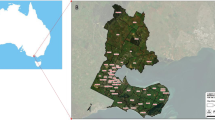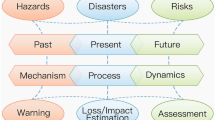Abstract
We simulate a large-scale flooding in the province of South-Holland in the economic centre of the Netherlands. In traditional research, damage due to flooding is computed with a unit loss method coupling land use information to depth-damage functions. Normally only direct costs are incorporated as an estimate of damage to infrastructure, property and business disruption. We extend this damage concept with the indirect economic effects on the rest of the regional and national economy on basis of a bi-regional input output table.We broaden this damage estimation to the concept of vulnerability. Vulnerability is defined as a function of dependence, redundancy and susceptibility. Susceptibility is the probability and extent of flooding. Dependency is the degree to which an activity relates to other economic activities in the rest of the country. Input–output multipliers form representations of this dependency. Redundancy is the ability of an economic activity to respond to a disaster by deferring, using substitutes or relocating. We measure redundancy as the degree of centrality of an economic activity in a network. The more central an activity is, the less it encounters possibilities to transfer production and the more vulnerable it is for flooding. Vulnerability of economic activities is then visualized in a GIS. Kernel density estimation is applied to generalize point information on inundated firms to sectoral information in space. We apply spatial interpolation techniques for the whole of the province of South-Holland. Combining information of sectoral data on dependency and redundancy, we are able to create maps of economic hotspots. Our simulation of a flood in the centre of Holland reveals the vulnerability of a densely populated delta.
Similar content being viewed by others
References
P. Blaikie T. Cannon I. Davis B. Wisner (1994) At Risk: Natural Hazards, People’s Vulnerability, and Disasters Routledge London
Cochrane H. C.: 1997, Forecasting the Economic Impact of a Midwest Earthquake. National Center for Earthquake Engineering Research Buffalo.
Cochrane H.C.: 2003, Economic Loss: Myth and Measurement, A. Van der Veen, A. L. Vetere Arellano, and J. -P. Nordvik, Joint NEDIES and University of Twente Workshop: In search of a common methodology on damage estimation, EUR Report 20997 EN, Office for Official Publications of the European Communities, European Commission, Bruxelles.
S. Cole (1998) Decision support for calamity preparedness: socioeconomic and interregional impacts M. Shinozuka A. Rose R. T. Eguchi (Eds) Engineering and Socioeconomic Impacts of Earthquakes MCEER Buffalo
Eding, G., Stelder, T. M., Vos, E. R., and Oosterhaven, J.: 1995, Bi-regionale Interactie, Groningen, REG, Stichting Ruimtelijk Economie Groningen.
EPA: 2000, Guidelines for preparing economic analyses, EPA 240-r-00-003, US Environmental Protection Agency.
InstitutionalAuthorNameFEMA (1999) Hazus: Technical Manual FEMA Washington, USA
O. Frank (2002) ArticleTitleUsing centrality modeling in survey networks Social Networks 24 385–394 Occurrence Handle10.1016/S0378-8733(02)00014-X
P. K. Freeman L. A. Martin R. Mechler K. Warner P. Hausmann (2002) Catastrophes and Development; Integrating natural catastrophes into development planning The World Bank Washington
S. O. Funtowicz J. R. Ravetz (1993) ArticleTitleScience for the post-normal age Futures 25 IssueID7 739–755 Occurrence Handle10.1016/0016-3287(93)90022-L
Green, C.: 2003, Evaluating vulnerability and resilience in flood management, A. Van der Veen, A. L. Vetere Arellano and J.-P. Nordvik (eds.), Joint NEDIES and University of Twente Workshop: In search of a common methodology on damage estimation, EUR Report 20997 EN, Office for Official Publications of the European Communities, European Commission, Bruxelles.
B. R. Hazari (1970) ArticleTitleEmpirical identification of key sectors in the Indian economy Rev. Econ. Statis. 52 IssueID3 301–305
InstitutionalAuthorNameIPCC (1998) The Regional Impacts of Climate Change: An Assessment of Vulnerability Cambridge University Press Cambridge
Kilkenny, M. and Nalbarte, L.: 1998, Keystone Sector Identification, TVA, Tennesee Valley Authority.
S. Leinhardt (Eds) (1997) Social Networks, a Developing Paradigm Academic Press New York
W. Leontief (1952) ArticleTitleSome Basic Problems of Structural Analysis Rev. Econ. Statis. 34 IssueID1 1–9
Leontief, W.: 1986, Input–Output Economics. In Leontief, W. Input Output Economics, 2nd edn. Oxford University Press, New York and Oxford; 3 18. Previously published: 1951.
N. Levine (2002) CrimeStat II: A Spatial Statistics Program for the Analysis of Crime Incident Locations, Crimestat Manual Ned Levine & Associates, TX, Natinonal INstitue of Justice Washington, DC
B. Lomborg (1998) The Skeptical Environmentalist Cambridge University Press Cambridge
InstitutionalAuthorNameMAFF (2000) Flood and Coastal Defense Project Appraisal Guidance: Economic Appraisal Ministry of Agriculture, Fisheries and Food London, UK
R. E. B. Miller P. D. Blair (1985) Input–Output Analysis: Foundations and Extensions University of Pennsylvania USA 100–147
D. J. Parker C. H. Green P. M. Thompson (1987) Urban Flood Protection Benefits, a Project Appraisal Guide Gower Aldershot
Perrings, C.: 2001. Resilience and Sustainability, H. Folmer et al. (eds.), Frontiers of Environmental Economics. Cheltenham, UK, Elgar; distributed by American International Distribution Corporation, Williston, VT.: Northampton, MA, pp. 319–41.
Rijkswaterstaat (2000) Ruimte voor rivieren Ministerie van Verkeer en Waterstaat, Directoraat-Generaal, Rijkswaterstaat Den Haag
A. Rose J. Benavides (1998) Regional economic impacts M. Shinozuka A. Rose R. T. Eguchi (Eds) Engineering and Socioeconomic Impacts of Earthquakes MCEER Buffalo
A. Rose D. Lim (2002) ArticleTitleBusiness interruption losses from natural hazards: Conceptual and methodological issues in the case of the Northridge earthquake Environ. Hazards 4 1–14 Occurrence Handle10.1016/S1464-2867(02)00012-8
C. Tallberg (2000) Comparing Degree-based and Closeness-based Centrality Measures Department of Statistics, Stockholm University Stockholm
M. Thurstain M. Batty M. Hacklay D. Lloyd R. Bodt A. Hyman S. Batty C. Tomalin C. Cadell N. Falk S. Sheppard S. Curtis (2001) Producing Boundaries and Statistics for Town Centres CASA, Center for Advanced Spatial Analysis London
M. Thurstain D. U. Goodwin (2000) Defining and Delineating the Central Areas of Towns for Statistical Monitorin Using Continuous Surface Representations Centre for Advanced Spatial Analysis London
InstitutionalAuthorNameUNEP (2002) Global Environmental Outlook 3 Earthscan London
Van der Veen, A., Steenge, A. E., Bockarjova, M. and Logtmeijer, C. J. J.: 2003a, Structural economic effects of large scale inundation: a simulation of the Krimpen dike breakage, A. Van der Veen, A. L. Vetere Arellano and J.-P. Nordvik (eds.) Joint NEDIES and University of Twente Workshop: In search of a common methodology on damage estimation, EUR Report 20997 EN, Office for Official Publications of the European Communities, European Commission, Bruxelles.
Van der Veen, A., Vetere Arellano, A. L., and Nordvik, J.-P.: 2003a, Joint NEDIES and University of Twente Workshop In search of a common methodology on damage estimation, EUR Report 20997 EN, Office for Official Publications of the European Communities, European Commission, Bruxelles.
N. Vrisouvan Eck M. Kok (2001) Standaard methode schade en slachtoffers als gevolg van overstromingen HKV & Dienst Weg- en Waterbouwkunde Lelystad & Delft
Author information
Authors and Affiliations
Corresponding author
Rights and permissions
About this article
Cite this article
Veen, A.V.D., Logtmeijer, C. Economic Hotspots: Visualizing Vulnerability to Flooding. Nat Hazards 36, 65–80 (2005). https://doi.org/10.1007/s11069-004-4542-y
Received:
Accepted:
Issue Date:
DOI: https://doi.org/10.1007/s11069-004-4542-y




